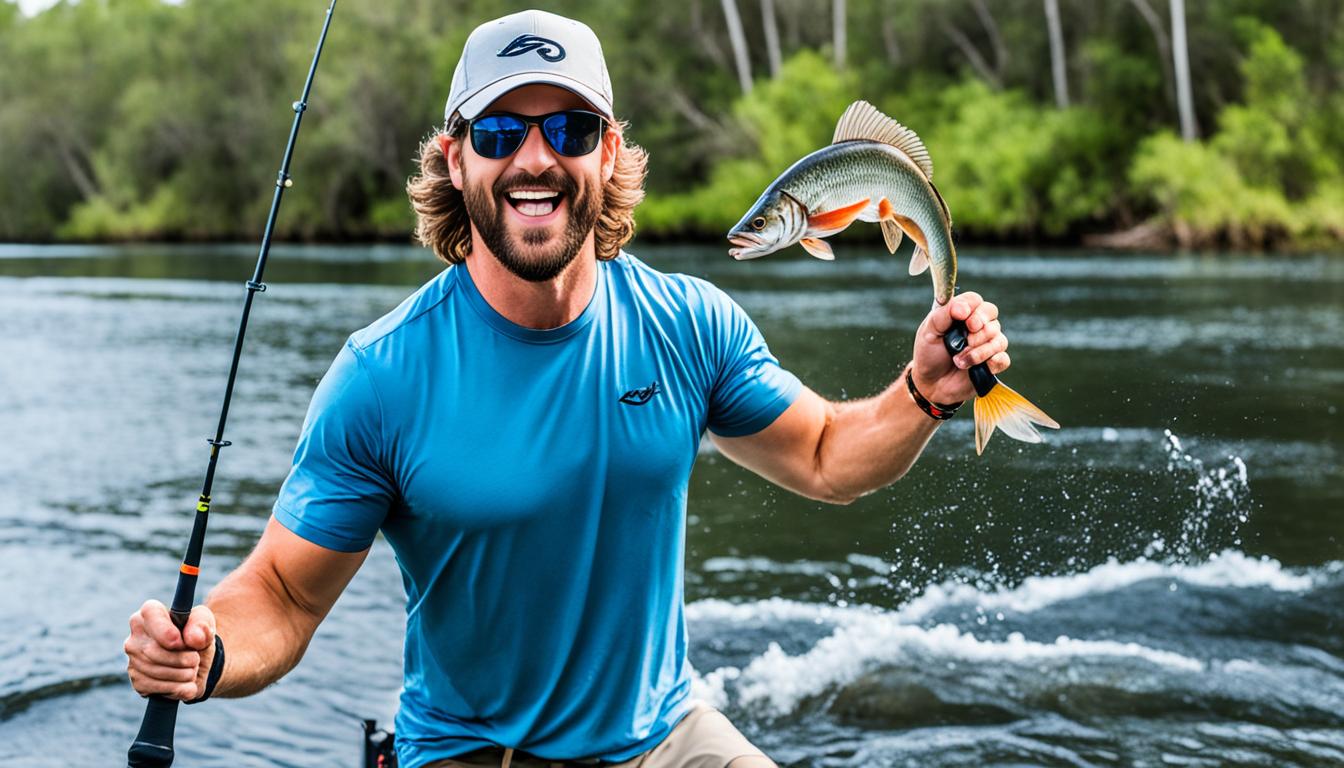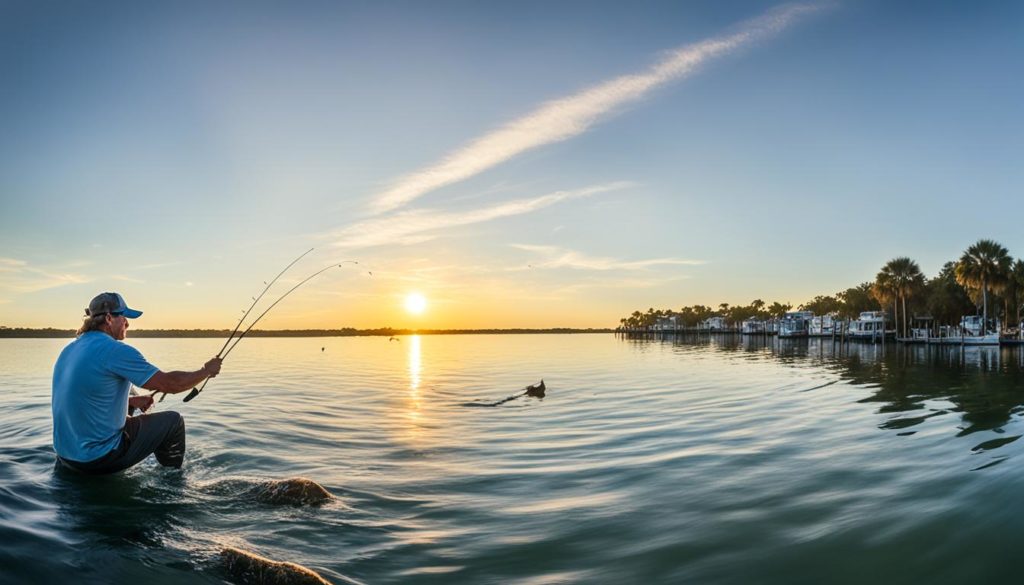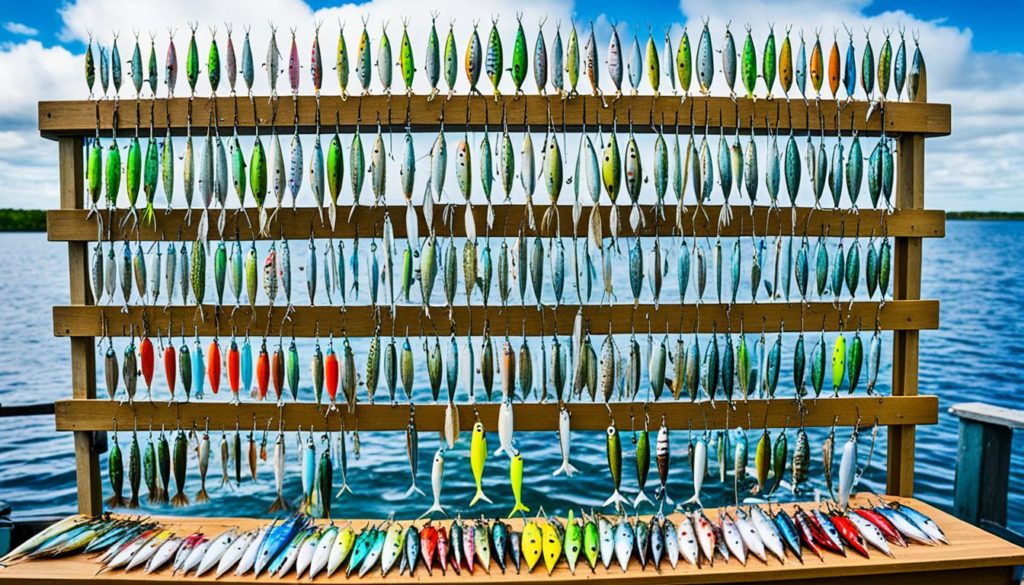If you’re an angler looking for an exciting fishing experience in Florida, mullet fishing should be at the top of your list. Mullet are not only a popular bait choice but also a fantastic gamefish in their own right. In this guide, we’ll provide you with the essential information and techniques to help you catch mullet easily.
Florida is home to two main species of mullet: silver mullet and black (striped) mullet. These fish can be found in various habitats, including rivers, bays, the Gulf of Mexico, Atlantic Ocean, freshwater lakes, and canals. Mullet travel in schools and can grow to sizes of 20 inches or more. They are a favorite prey item for a wide range of fish species, making them an ideal bait for catching snook, jacks, tarpon, redfish, trout, and cobia.
Key Takeaways:
- Florida offers excellent mullet fishing opportunities in various water bodies.
- Mullet are a universal prey item for many gamefish species.
- Mullet can be caught using a variety of techniques and bait options.
- Knowing the mullet fishing regulations in Florida is crucial for a successful and legal fishing trip.
- The mullet run from August to November is a prime time for mullet fishing on the east coast of Florida.
Where to Catch Mullet in Florida
Mullet can be found in various locations across Florida, making it an accessible and exciting fishing experience. Here are some popular spots where you can target these elusive fish:
- Sand bars: Mullet seek cover in shallow areas like sand bars, where they can evade predators and find ample food sources.
- Flats: Shallow flats provide an ideal habitat for mullet, as they offer abundant forage and protection from larger predators.
- Mangroves: These unique ecosystems offer shelter and food for mullet, attracting them to the tangled roots and providing anglers with excellent fishing opportunities.
If you’re unsure where to start, look for areas with jumping fish or disturbed water. This indicates the presence of mullet schools. Additionally, be aware that mullet are commonly found near the shore, especially during the mullet run from August to November on the east coast of Florida.
It’s important to note that while there are many mullet fishing spots in Florida, it’s essential to familiarize yourself with the mullet fishing regulations. These regulations ensure the sustainable management of the fishery and help preserve the populations for future generations.
Always check the Florida Fish and Wildlife Conservation Commission (FWC) website or consult the current fishing regulations guide for the most up-to-date information on bag limits, size restrictions, and other regulations that may apply to mullet fishing in Florida.
Tools and Techniques for Catching Mullet
To catch mullet, you’ll need a cast net and some patience. Look for jumping mullet or “nervous” water to locate schools. A cast net with a ½- to 1-inch mesh is recommended for catching mullet. The size of the net will depend on your fishing location and method (land-based or boat). Lighter nets are preferred when fishing from land or wading, while larger nets are suitable for shallow water or boat fishing.
When rigging a livelined mullet, you can hook them in the upper jaw or below the second dorsal fin, depending on the desired swimming behavior. Circle hooks are recommended for mullet fishing, as they increase the chances of a successful hookup. Additionally, consider using weighted rigs or jigheads for fishing deeper water or around structures.
| Tool/Technique | Description |
|---|---|
| Cast Net | A cast net with a ½- to 1-inch mesh is recommended for catching mullet. Choose the appropriate size based on your fishing location and method. |
| Circle Hooks | Circle hooks are ideal for mullet fishing, increasing the chances of a successful hookup. |
| Weighted Rigs/Jigheads | Consider using weighted rigs or jigheads when fishing in deeper water or around structures. |
With these tools and techniques, you’ll be well-equipped to catch mullet and enhance your fishing experience. Remember to practice good fishing ethics, respect fishing regulations, and enjoy the thrill of mullet fishing!
Bait Selection and Sizing
Choosing the right bait and size is crucial when it comes to mullet fishing. The size of the mullet bait you select will depend on your target species and the type of fishing experience you’re seeking. Here are some essential tips to help you make the best choices for your fishing goals.
When it comes to mullet bait, “finger” mullet are highly effective for attracting a variety of species, including trout, reds, snook, tarpon, and jacks. Finger mullet are smaller mullet ranging between 3 and 6 inches in length. Their size makes them an enticing target for these predator fish.
If you’re aiming for bigger fish and want to avoid catching smaller ones, opting for larger mullet bait is recommended. The general rule is that the larger the bait, the bigger the catch. Larger mullet can grab the attention of larger predator fish, increasing your chances of landing a trophy-sized catch.
However, keep in mind that during colder months, bigger fish may also focus on smaller presentations. This means that even if you’re targeting big fish, experimenting with different sizes of mullet bait can be beneficial. Be open to trying various sizes to see what works best for your specific fishing goals.
Remember, mullet fishing is as much an art as it is a science. Don’t be afraid to adapt and adjust your bait selection and sizing based on the conditions, the time of year, and the behavior of the fish. The more you experiment and fine-tune your approach, the more effective you’ll become at landing that prized catch.
Fishing Techniques for Mullet
When it comes to mullet fishing, mastering the right techniques can greatly enhance your success rate on the water. Whether you’re targeting snook, redfish, or other predatory fish, understanding how to effectively fish with mullet is key. Here are some expert tips to help you refine your mullet fishing skills:
- Flipping Docks, Seawalls, and Mangroves: These structures provide excellent cover and ambush points for fish that prey on mullet. When fishing near these structures, cast your bait as close to them as possible. Use a slow, deliberate retrieve to imitate the natural movements of mullet, enticing strikes from hungry fish.
- Fishing the Edges of Mullet Schools: Predatory fish often lurk on the edges of mullet schools, looking for an easy meal. Position yourself near the outskirts of the school and cast your bait into these areas. The commotion created by the mullet can trigger aggressive strikes from nearby predators.
- Slow-Trolling Deepwater Mullet Pods: If you’re targeting species like king mackerel or barracuda, slow-trolling around deepwater mullet pods can be highly effective. This technique allows you to cover more ground and present your bait to a wider range of predatory fish.
- Night Fishing Near Underwater Lights or Docks: Many fish species are drawn to areas where mullet gather to feed at night. Look for underwater lights or docks where fish congregate during this time. Target these areas with your mullet bait, as fish will actively search for an easy meal in the darkness.
By incorporating these mullet fishing techniques into your arsenal, you’ll increase your chances of landing that trophy fish you’ve been dreaming of. Remember, patience and persistence are key when it comes to successful mullet fishing.
Snook Fishing During the Mullet Run
The mullet run in Florida is a highly anticipated event for avid anglers, and it presents an excellent opportunity for snook fishing. The abundance of mullet attracts snook to various locations along the beaches, rivermouths, and inlets. To successfully target snook during the mullet run, you have two options for bait: live mullet or artificial mullet imitations.
If you prefer live bait, you can use freshly caught mullet from your cast net. It’s best to select a live mullet that closely matches the size of the mullet running in the area. Snook are known for their preference for mullet, so this bait choice will significantly increase your chances of a successful catch.
If you prefer artificial bait, there are many high-quality mullet imitations available on the market. These lures are designed to mimic the appearance and swimming action of mullet, making them irresistible to snook. Consider using swimbaits, jerkbaits, or topwater plugs in mullet colors to entice strikes from snook during the mullet run.
Fishing early in the morning or at night will further enhance your chances of success. Snook are often more active during low-light conditions, so plan your fishing trips accordingly. However, be sure to check the state regulations regarding snook sizes and limits to ensure you are in compliance.
During the mullet run, snook congregate in areas where mullet are plentiful, making them an exciting target for anglers. Whether you choose to use live mullet or artificial mullet imitations, be prepared for an adrenaline-pumping fishing experience as you try to hook these prized gamefish.
Redfish Fishing During the Mullet Run
The mullet run coincides with the redfish autumn spawning run, making it an excellent time to target these fish. Redfish, also known as red drum, are a popular gamefish species found in Florida’s coastal waters. They are known for their powerful fighting ability and tasty fillets, making them a sought-after catch for both recreational and commercial anglers.
During the mullet run, redfish often gather in areas where mullet pods are present. These areas include slick water near rivermouths or breaking surf. Mullet serve as a primary food source for redfish, and they feed aggressively on these small baitfish. Targeting redfish during the mullet run can be highly productive, as they actively pursue mullet schools, creating exciting fishing opportunities.
When fishing for redfish during the mullet run, it is important to adhere to state regulations regarding size and bag limits. Ensure you are familiar with the specific regulations for the particular area you plan to fish. To successfully catch redfish, you can utilize a variety of fishing techniques depending on your preference and the prevailing conditions.
One popular technique for targeting redfish during the mullet run is using live or artificial bait that imitates mullet. This can include soft plastic lures, such as paddle tails or jerkbaits, that resemble the shape and swimming action of mullet. You can also use natural bait, such as live mullet or mullet chunks, to entice redfish into biting.
When presenting your bait, cast it near mullet schools or areas where redfish are actively feeding. Redfish often patrol the edges of these schools, waiting for an opportunity to strike. Use a slow, steady retrieve or a twitch-and-pause technique to mimic the natural movements of mullet and trigger a reaction from redfish.
Additionally, consider targeting redfish using topwater lures. These lures create surface disturbances that simulate the commotion caused by feeding mullet, attracting the attention of nearby redfish. Topwater lures like poppers, walkers, and prop baits can be effective in enticing aggressive strikes from hungry redfish.
It’s important to experiment with different techniques, lures, and presentations to determine what works best in your fishing location and conditions. Pay attention to the behavior of redfish and their interactions with the mullet schools to refine your strategy and increase your chances of success.
When planning your redfish fishing trip during the mullet run, be sure to choose well-known mullet fishing spots in Florida that are known to attract large schools of mullet and the redfish that follow them. Understanding the mullet fishing season in Florida will also help you plan your trip to coincide with the most productive times for targeting redfish.
Keep in mind that redfish have a slot limit, which means only fish within a specific size range can be harvested. Any redfish caught outside of the designated slot limit must be released unharmed. Practicing catch-and-release not only ensures the sustainability of the redfish population but also allows other anglers to enjoy the thrill of catching these prized gamefish.
| Redfish Fishing Tips During the Mullet Run |
|---|
| 1. Look for areas with mullet pods, such as slick water near rivermouths or breaking surf. |
| 2. Use live or artificial bait that imitates the appearance and movement of mullet. |
| 3. Experiment with different fishing techniques, such as slow retrieves or twitch-and-pause techniques. |
| 4. Consider using topwater lures to create surface disturbances that attract redfish. |
| 5. Follow state regulations regarding size and bag limits for redfish. |
| 6. Practice catch-and-release for redfish that fall outside the designated slot limit. |
With the right techniques, knowledge of mullet fishing spots in Florida, and an understanding of the mullet fishing season, you can increase your chances of catching redfish during the mullet run. Enjoy the thrilling experience of targeting these powerful and prized gamefish as they actively feed on mullet in Florida’s coastal waters.
Tarpon Fishing During the Mullet Run
The mullet run is a prime time for tarpon fishing in Florida. Tarpon are known to feed on mullet and can provide exciting angling opportunities. Look for tarpon crashing bait and leaping out of the water along the beach or inshore areas. Using live or artificial mullet bait can attract tarpon to your line. Tarpon fishing during the mullet run can be fast-paced and exhilarating.
Other Species to Target During the Mullet Run
While snook, redfish, and tarpon are the main targets during the mullet run, there are other species that can also be caught. Jack crevalle, bluefish, Spanish mackerel, and sharks are known to feed on mullet and can provide additional angling opportunities.
When targeting these species, it’s important to employ effective mullet fishing techniques. Pay attention to the behavior of the mullet and use bait or lures that mimic their appearance and movement. Cast near schools of mullet or areas where you see feeding frenzies to increase your chances of success.
Fly-fishers can especially enjoy the action during the mullet run. The sight of fish chasing after mullet can create thrilling moments and offer unique fly-fishing opportunities.
Remember to always check and adhere to state regulations when targeting different species during the mullet run. Ensure that you are only keeping fish that are within the legal size and bag limits.
Now, let’s take a look at some popular mullet fishing spots in Florida where you can target these species:
| Mullet Fishing Spots in Florida | Description |
|---|---|
| Sebastian Inlet State Park | A renowned fishing spot on the east coast of Florida known for its abundance of snook, redfish, and tarpon during the mullet run. |
| St. George Island State Park | This barrier island park offers opportunities to catch a variety of species, including jacks, Spanish mackerel, and bluefish. |
| Honeymoon Island State Park | Famous for its clear waters and diverse fish population, including sharks that feed on mullet. |
| Everglades National Park | An expansive wilderness known for its abundance of fish, where you can target a variety of species that feed on mullet. |
These mullet fishing spots in Florida offer great opportunities to target a range of species during the mullet run. As always, be sure to research and acquire any necessary permits or licenses before fishing in these areas.
Best Lures for the Mullet Run
When targeting fish during the mullet run, it’s essential to have the right lures in your tackle box. Lures that imitate the color and behavior of mullet are most effective. Here are some popular options:
- LIVETARGET Mullet SwimBait: This swimbait accurately replicates the appearance and movement of a mullet, making it irresistible to predatory fish.
- Z-Man Diezel Minnowz with Trout Eye Jig Head: The combination of the realistic minnow profile and the convincing action of the jig head makes it a go-to lure for catching fish that feed on mullet.
- MirrOlure’s 52 MR: This classic crankbait mimics the look and swimming motion of a mullet, enticing strikes from hungry fish.
Experiment with different retrieves and pauses to trigger bites from predatory fish. Vary your retrieval speed, use jerking motions, and incorporate pauses to simulate the erratic movements of mullet. By imitating the behavior of mullet, you can increase your chances of success during the mullet run.
Tips for Using Lures During the Mullet Run
When using lures to target fish that are feeding on mullet, it’s important to consider the following tips:
- Match the color of the lure to the color of the mullet in the area you are fishing.
- Choose lures with a lifelike swimming action to attract predatory fish.
- Use lures of different sizes to match the size of the mullet that the fish are feeding on.
- Pay attention to the depth at which the mullet are swimming and select lures that can be fished at that depth.
“During the mullet run, fish are actively feeding on mullet, so it’s important to use lures that closely resemble the behavior and appearance of these baitfish.”
Conclusion
The mullet run in Florida provides anglers with exciting opportunities to catch a variety of gamefish. By understanding the behavior and habits of mullet and utilizing the right bait, gear, and techniques, you can significantly increase your chances of success when mullet fishing in Florida. Whether you’re targeting snook, redfish, tarpon, or other species, the mullet run offers a thrilling fishing experience.
Remember to always adhere to fishing regulations and practice catch-and-release when necessary. By doing so, you can help preserve the fish populations and ensure sustainable fishing for future generations. So grab your cast net, equip yourself with the proper gear, and get ready to master the art of mullet fishing in the beautiful waters of Florida.
Explore the diverse fishing spots in Florida, from the shallow flats to the deep offshore waters, and discover the excitement of tangling with snook, redfish, tarpon, and other species during the mullet run. With the right techniques and a little patience, you’ll be reeling in those prized catches and creating lifelong memories. Get out there and enjoy the thrill of mullet fishing in the Sunshine State!
FAQ
How do I catch mullet in Florida?
To catch mullet in Florida, you will need a cast net and some patience. Look for jumping mullet or “nervous” water to locate schools. Use a cast net with a ½- to 1-inch mesh and throw it over the mullet to catch them.
Where can I find mullet in Florida?
Mullet can be found in various habitats in Florida, including rivers, bays, the Gulf of Mexico, Atlantic Ocean, freshwater lakes, and canals. They often congregate in shallow areas like sand bars, flats, and around mangroves.
What bait is best for catching mullet?
The best bait for catching mullet is other smaller mullet. Use live or artificial mullet bait to attract them and entice strikes from predatory fish.
What gear do I need for mullet fishing?
For mullet fishing, you will need a cast net with a ½- to 1-inch mesh, a fishing rod and reel, and appropriate fishing line and tackle. Circle hooks are recommended for mullet fishing, and consider using weighted rigs or jigheads for fishing deeper water or around structures.
What size mullet bait should I use?
The size of the mullet bait you choose will depend on your target species. “Finger” mullet, which are smaller mullet between 3 and 6 inches in length, are great for attracting trout, reds, snook, tarpon, and jacks. Larger mullet are preferred for targeting bigger fish.
What are some fishing techniques for catching mullet?
When fishing for mullet, consider flipping docks, seawalls, and mangroves, as these structures provide cover and ambush points for fish targeting mullet. Another technique is to fish the edges of mullet schools, where predatory fish often lurk. Slow-trolling around deepwater mullet pods can also attract king mackerel and barracuda.
Can I catch other fish during the mullet run?
Yes, other fish such as snook, redfish, tarpon, jack crevalle, bluefish, Spanish mackerel, and sharks can also be caught during the mullet run. They are known to feed on mullet and can provide additional angling opportunities.
What are the best lures for the mullet run?
Lures that imitate the color and behavior of mullet are most effective during the mullet run. Some popular options include the LIVETARGET Mullet SwimBait, Z-Man Diezel Minnowz with Trout Eye Jig Head, and MirrOlure’s 52 MR. Experiment with different retrieves and pauses to trigger bites from predatory fish.
When is the mullet run season in Florida?
The mullet run season in Florida typically occurs from August to November on the east coast. However, mullet can be found in Florida waters throughout the year.



